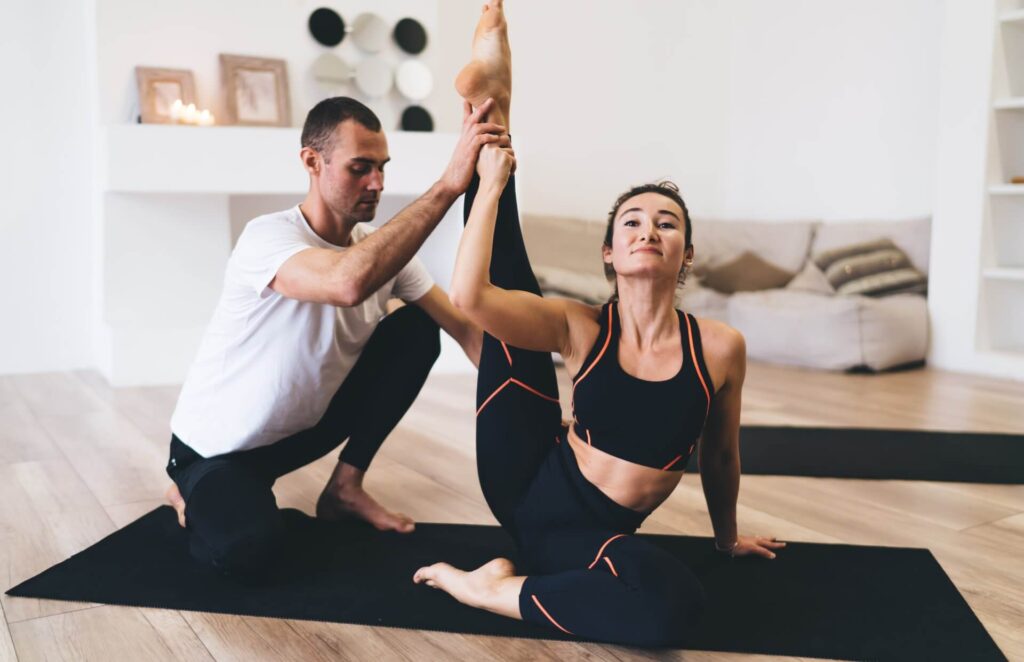“Parivrtta Surya Yantrasana – Where Yoga Becomes Poetry, and Your Body, the Brushstroke”
In the world of yoga, where each pose tells a story, Parivrtta Surya Yantrasana, commonly known as Compass Pose, unfolds as an intricate masterpiece of balance and flexibility. This advanced asana, like poetry, invites practitioners to delve into its origins, meaning, strengths, and intricacies.
Origins and Symbolism
Parivrtta Surya Yantrasana has its roots in Hatha yoga, with no specific mythological origin. Its symbolism lies in the harmony of the pose, mirroring the elegance of a compass or a beautifully drawn yantra, a sacred geometric pattern representing the universe. Just as a compass points the way, this pose guides the practitioner towards balance and harmony.
Strengths and Benefits
- Hip and Hamstring Flexibility: Compass Pose offers an intense stretch to the hips and hamstrings, increasing flexibility.
- Spinal Mobility: The twisting motion engages the spine, enhancing its flexibility and mobility.
- Core Strength: Balancing in this pose activates the core muscles, improving strength and stability.
- Mental Focus: Achieving and holding the pose requires concentration and mental presence.
How to Perform Compass Pose

Perform Compass Pose – Parivrtta Surya Yantrasana with these step-by-step instructions:
- Seated Position: Begin in a seated position with your legs extended in front of you, feet flexed.
- Right Leg Lift: Bend your right knee, lifting your right foot off the mat. Hug your right knee close to your chest.
- Right Arm Through: Slide your right arm through the space between your right shin and thigh. Reach your right hand behind your back, fingertips pointing up.
- Left Arm Wrap: Extend your left arm out to the side, parallel to the floor. Wrap it around your right leg, reaching for your right hand.
- Twist and Fold: Begin to twist your torso to the right, folding over your right leg. Bring your forehead as close to your right knee as possible.
- Breathe and Hold: Maintain the pose for 20-30 seconds, breathing deeply and focusing on the twist and stretch.
- Release and Repeat: Slowly release the pose and switch to the other side, following the same steps.
Difficulty Level and Duration
Compass Pose is considered advanced due to its complexity and demands on flexibility. Beginners may find it challenging, but with practice, it becomes more accessible. Aim for 20-30 seconds on each side.
Preparation Compass Pose
Preparation Poses
- Seated Forward Bend (Paschimottanasana): Seated Forward Bend is an excellent preparation for Compass Pose, as it stretches the hamstrings, improves hip flexibility, and cultivates the forward fold motion required for Compass Pose. Sit with your legs extended in front of you, flex your feet, and hinge at your hips to reach for your toes while keeping your back straight.
- Legs-Up-The-Wall Pose (Viparita Karani): This restorative pose helps open up the hamstrings and relieve tension in the lower back, making it a beneficial preparatory pose for Compass Pose. Lie on your back with your legs extended up a wall or a sturdy surface, keeping your buttocks close to the wall.
- Happy Baby Pose (Ananda Balasana): Happy Baby Pose can help improve hip flexibility and prepare your hips for the leg positioning in Compass Pose. Lie on your back, bend your knees, and draw them toward your chest. Hold onto the outsides of your feet with your hands, keeping your knees wide apart.
Counter Poses Compass Pose
Counter Poses
- Child’s Pose (Balasana): After practicing Compass Pose, release any tension in your hips and lower back with Child’s Pose. Kneel on the floor, sit back on your heels, and extend your arms forward while lowering your chest toward the ground. Child’s Pose provides a gentle stretch and relaxation for the spine and hips.
- Seated Forward Bend (Paschimottanasana): Returning to Seated Forward Bend can help stretch and reset your hamstrings and lower back after Compass Pose. Sit with your legs extended in front of you, flex your feet, and hinge at your hips to reach for your toes while keeping your back straight.
- Downward-Facing Dog (Adho Mukha Svanasana): Downward-Facing Dog serves as a counterbalance to Compass Pose. Start on your hands and knees, then lift your hips upward, forming an inverted V shape with your body. This pose stretches the entire body and provides a gentle inversion to balance the effects of Compass Pose.
Final Thoughts
As we reach the Final Thoughts of our exploration of Parivrtta Surya Yantrasana, the Compass Pose, let it be a reminder that in the world of yoga, our bodies become the brushstrokes of a beautiful painting, creating poetry through movement.
Just as a compass guides a traveler on their journey, this pose guides us toward greater flexibility, balance, and mental focus. Embrace the artistry of Compass Pose, allowing it to be your compass in the vast landscape of yoga, where your practice becomes a masterpiece, and each pose tells a unique story of strength, grace, and self-discovery.


